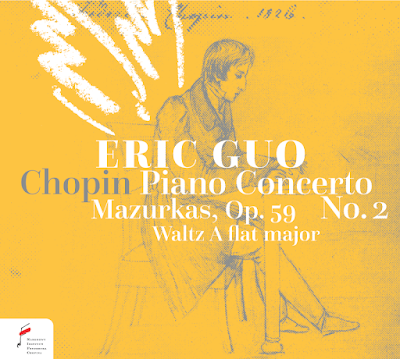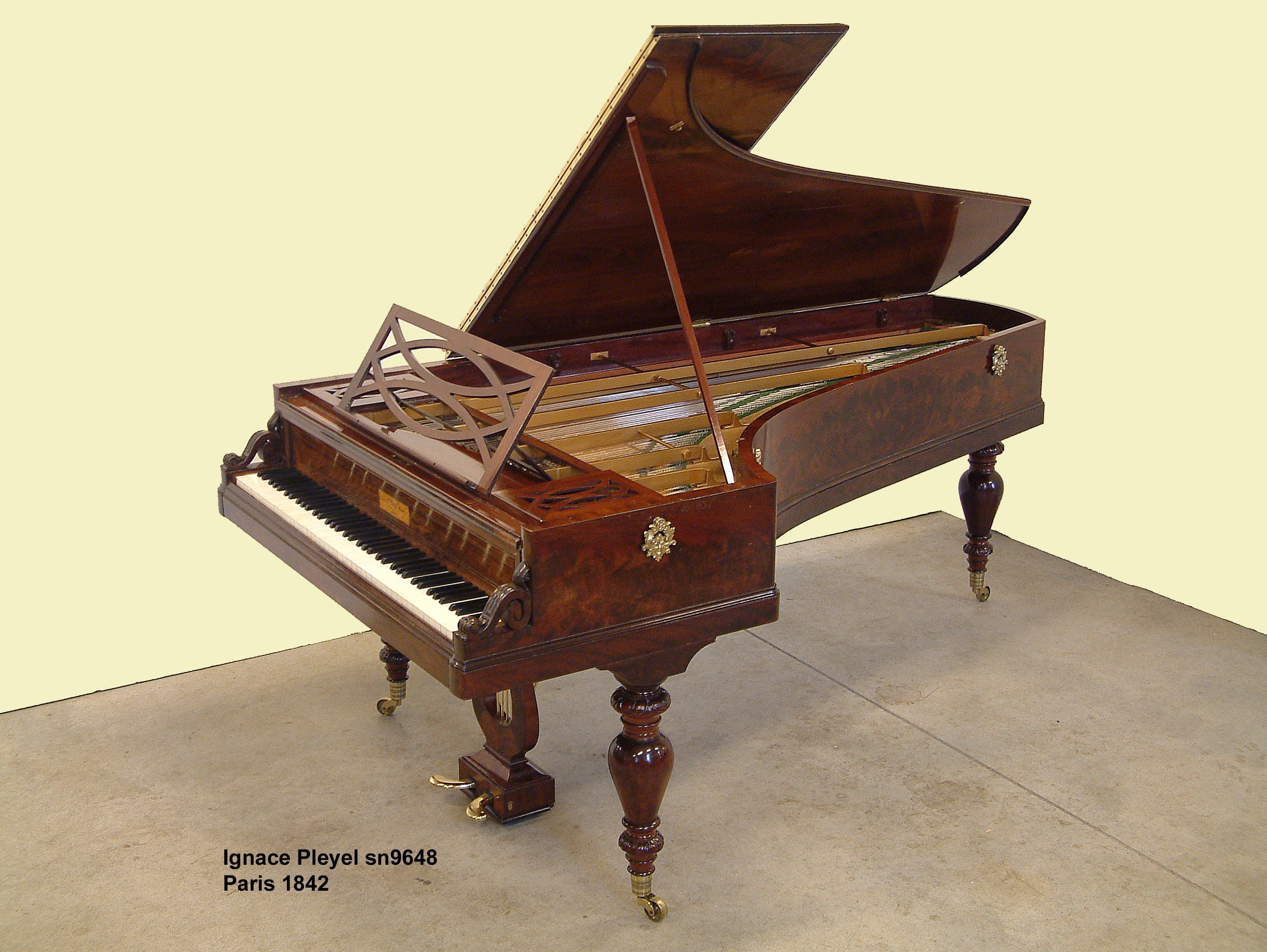Review of the competition recording by Eric Guo, winner of the 2nd. International Chopin Competition on Period Instruments. Warsaw 2023
 |
https://sklep.nifc.pl/en/produkt/77458-eric-guo |
Fryderyk Chopin
Piano Concerto in E minor, Op.
11
Václav Luks conducts the [oh!] Orchestra
Allegro maestoso
I attended this concerto during the competition. The fact this pianist is a great communicator (vital in a concert artist) was obvious from the first embracing smile towards the audience. His playing is a marvellous example of coherent musical speech with a variety of timbre, tone and dynamics. One is struck by his fertile musical imagination and extrovert personality. He demonstrated the variegated sound and colour potential of a period piano. We were offered bravura playing, style brillante and ultra-pianissimo effects that were as elegant and delicate as Venetian Burano lace. His dramatic accumulation of vivid colours and variety of touch, timbre and the revelation of polyphony came to a triumphant conclusion.
Romance. Larghetto
Guo adopted a natural, unexaggerated or mannered tempo and did not indulge the sentimental romantic side so tempting to pianists of Chopin. He seemed particularly well integrated with the orchestra and conductor as the soloist. His eloquent phrasing, use of silence as sound, lace-like fiorituras revealed the sensitive potential of the 1842 Pleyel for expressive timbre, dynamics, tone and refined touch. What the Pleyel can do under the right fingers! The conclusion was luminous and supremely refined with sensibility of the age.
Rondo.
Vivace
This movement follows immediately from the Romance marked attacca (without pause). I felt the dramatic change of mood to spontaneously throw aside romantic 'dwelling', aspiration or regret and launch into a healing, distracting and joyful dance.
His intense enjoyment of this movement was clear in his abundant style brillante style and sound, the sheer energy he brought to the Polish krakowiak dance. An extraordinary range of colour, touch, articulation, texture, tone and touch came into play. I found this movement brilliantly expressive and even more rarely, full of spontaneous invention. Many arresting and eloquent internal voices I had never before heard were revealed, particularly towards the conclusion. The pianissimo on the Pleyel as Guo executed it is like a gossamer cobweb, dew dappled, stirring in the whispered breeze.
 | |
|
As all the competitors chose this concerto, first a few words about the E Minor Piano Concerto Op.11 and how I conceive of it. The reviews will then perhaps make a little more sense as seen through the inescapable filter of my own life and musical experience, that of just one listener.
As is well known, although designated No.1, it is actually his second concerto. The first written was in F-minor Op.21. The issue is not of the greatest chronological significance because Chopin’s two piano concertos were composed within a year of each other. I am always amazed at the nature of true genius as it was written when Chopin was in his late teens. Perhaps this is why fine performances are often during the International Chopin Piano Competitions in Warsaw when performed by young pianists of much the same age as the composer. At its premiere in 1830, he played the piano part himself, and the concert marked his final public appearance as a pianist in Poland. Soon Chopin was to leave for Vienna and then Paris, where he remained for the rest of his life.
The opening Allegro movement has the character maestoso which we find in the noble and proud polonaises, a measured grandiosity that should be dispatched with èlan and poetry. The style brillante of the period should be clear to hear in its animation and what in Chopin's day was termed 'enthusiasm'. Graceful rhapsodic sweeps remind me of eagles taking updrafts in the High Tatras. There are calm moments of reflection and fiorituras as delicate as Koniakowska lace.
Attempts to transform musical experience into the very different language of words is fraught with difficulties. The Romance-Larghetto has always taken me on an imaginative poetic flight as it did Chopin himself when he wrote to his close friend. In this Larghetto (there is another in the F-minor concerto)– its character clarified in the score, following Mozart as a Romance (the sole occasion Chopin used this designation in a piece) – a type of poetic reverie. In a letter to Tytus Woyciechowski, the composer wrote 'It is not meant to create a powerful effect; it is rather a Romance, calm and melancholy, giving the impression of someone looking gently towards a spot that calls to mind a thousand happy memories. It is a kind of reverie in the moonlight on a beautiful spring evening.'
Bear with me
as I fight to describe in concrete words the effect this movement has on
me.
The divine
melody at this slow tempo is perfectly ardent, one of the most beautiful love
songs ever written. Lethargy from dreams begins to awake in a slow movement of
unblemished, illusioned rapture. I conceive of it in daylight. In
sunlight-dappled groves, lovers lie in long grass by a stream among birches and
willows as summer clouds drift hesitantly towards the horizon. The heart rises
with the swallow as leaves fall and drift on a slight breeze. Gossamer spider
webs glisten in the sun in this slow dance of the heart. A threatening shadow
of doubt and a sudden cool chill in the air soon passes as dusk falls, the last
pianissimo note of love thrown towards us by hand.
The Rondo follows attacca, without a pause, rousing us from poetic dreams and reveries with robust dance rhythms vivace and rhapsodic gestures. Here we encounter the playfulness, dancing, acting and extreme good humor of Chopin the young man, a neglected aspect of his character in the received paradigm of the later consumptive melancholic. There is the character of the Polish krakowiak dance here, a syncopated, duple-time popular dance in contemporary Krakow. The characteristic rhythm, liveliness and amusement should be expressed with colour and verve. The theme of the episode – led in octave unison against the pizzicato of the strings – is all born of the virtuosic style brillante. The entire musical population of Warsaw was drawn to the National Theatre for the premiere. One young singer was Konstancja Gładkowska. ‘Dressed becomingly in white, with roses in her hair' as Chopin romantically described her. She sang the cavatina from Rossini’s La donna del lago.
3
Mazurkas, Op. 59
No. 1 in A
minor
No. 2 in A
flat major
No. 3 in F sharp minor
The late Chopin mazurkas Op. 59 were replete with musical meaning from his instinctively wrought phrasing. He brought to them so much variety of mood, sound, tone and rhythm. A feeling of nostalgia was marvellously expressed yet in a spirited fashion. His Chopin mazurka emerged as a song, singing phrases with a superb return of the melody. I could not help marvelling at Chopin’s adventurous harmonic transitions which must have sounded revolutionary, if not inaccessible, in the day.
Guo is an hypnotic player who takes you irresistibly and willing into his musical orbit.
He was awarded the competition prize for the best performance of Mazurkas by the Polish National Radio 2 (Dwojka)
Waltz A flat major, Op. 42
His delightful, stylish waltz created a luminously melancholic recall of past happy memories.
This piano (serial no. 9648) was made by Pleyel in
1842. In 1989, it was bought from Giuseppe Accardi for the collection of Edwin
Beunk. This mahogany-veneered instrument has a composite frame with five stress
bars. The strings are largely iron, only brass-wound in the bass. This piano
has an English double-escapement action, a keyboard range of 6²⁄3 octaves
(C1–g4), and two pedals: damper and una corda. It underwent conservation work
in 1989 and 2007, with the strings and the felt of the dampers replaced.





Comments
Post a Comment